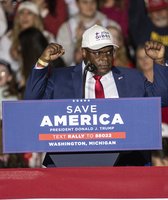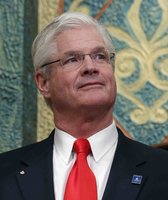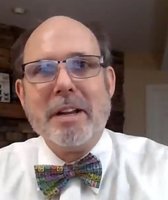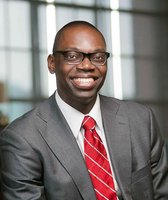Get PolitiFact in your inbox.
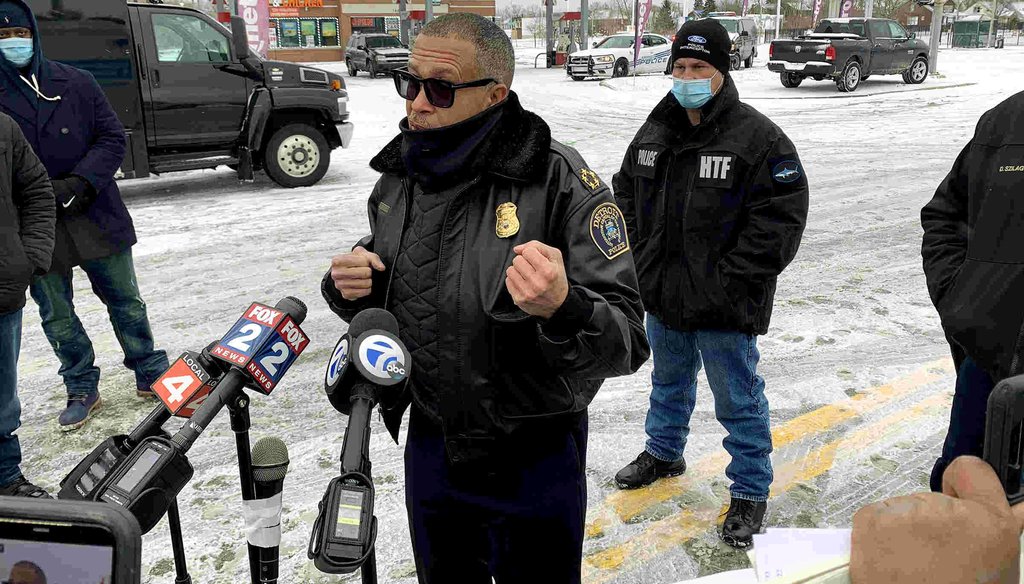
Detroit Police Chief James Craig speaks to the media after an incident at their 5th Precinct on Conner Street. (Kimberly P. Mitchell, Detroit Free Press)
If Your Time is short
-
Detroit Police Chief James Craig pushed back against the idea that the police response to Black Lives Matter protesters compared to the pro-Trump insurrectionsts who stormed the Capitol shows clear disparities in law enforcement.
-
Policing experts say that the police response to the two groups stands in stark contrast.
In the wake of the deadly assault on the U.S. Capitol, Detroit Police Chief James Craig questioned whether law enforcement’s treatment of the pro-Trump insurrectionists stands in stark contrast to Black Lives Matter protesters.
Black Lives Matter supporters, Democratic lawmakers and President-elect Joe Biden have claimed that the police response to the two groups points to clear disparities. But Craig isn’t so sure.
"If it was a Black Lives Matter, African-Americans converging on the Capitol, would there have been a different response? Possibly so," Craig said during an interview with Fox 2. He then went on to challenge that proposition.
"When you look at the Black Lives Matter protests in say Seattle, they were allowed to take over six city blocks without resistance. They took over police stations," Craig said, later repeating his comments in an interview with the Detroit News. In Seattle, Black Lives Matter protesters occupied a police precinct in June and set up an autonomous zone surrounding the building.
Experts on policing say that there is a clear discrepancy between law enforcement’s response to Black Lives Matter protesters and Trump supporters who converged on the Capitol and that Craig is cherry-picking one example.
In response to a request for comment, Craig pointed to other instances in which he says Black Lives Matter protesters who were breaking the law were met with little to no resistance. "I did pull out Seattle as one example, but I saw many other examples. I saw images coming out of Philadelphia where a protest turned riotous, there was looting, the police officers retreated and you could see people running out of stores with items without resistance."
Craig added, "Granted, there were police departments at different times across the nation during the summer that did respond to violent attacks at times."
Craig said he believes preparations for Black Lives Matter protests in Washington compared to the pro-Trump demonstrations did reveal a disparity in law enforcement and that the insurrectionists did more to disrupt the rule of law than Black Lives Matter protesters over the summer. "This was an attack on our democracy," he said.
Policing experts say the insurrection was not perceived to pose the same level of threat as Black Lives Matter protests nor met with anywhere near the escalation of force used against protesters over the summer.
Rashawn Ray, a sociologist who researches policing at the Brookings Institution, said the deployment of forces in response to Black Lives Matter protests in Washington, D.C. demonstrated a belief that the protests posed a violent threat.
"We actually have an apples-to-apples comparison," he said. By the end of the first week of Black Lives Matter protests in June, the Trump administration deployed at least 5,800 troops, agents and officers to patrol the streets of the nation’s capital.
Ahead of the pro-Trump demonstrations, on the other hand, the U.S. Capitol Police expected a largely peaceful protest despite multiple reports that Trump supporters openly discussed online attacking the Capitol.
And unlike Black Lives Matter protests which saw the police maintain skirmish lines, many of which were unnecessary, said Arizona State University criminologist Ed Maguire, there was no such line maintained on Jan. 6 when Maguire said it was needed.
"It’s hard to imagine a piece of critical infrastructure more valuable than the U.S. Capitol, the center of our legislative branch, so you want to have a heavily defended skirmish line in this case and what we ended up with was a porous, poorly defended skirmish line," Maguire said.
There is evidence that police treat right- and left-leaning protesters differently. In a recent paper, sociologist Lesley Wood of the University of York analyzed 64 protests that occurred in the U.S. in 2017 and 2018 that attracted counter-protesters, which tends to increase the likelihood of violent confrontation. She found that police disproportionately arrested left-leaning protesters.
But Craig pointed to Seattle where the city’s mayor — not the police chief — made the decision to remove barriers around a police precinct as an inadequate response to Black Lives Matter protesters that mirrors failures he saw in the response to the insurrectionists who stormed the Capitol. "In those instances where law enforcement retreated and didn’t respond to criminal behavior by BLM protesters, what’s different with that than what was seen in the Capitol?"
But looking at police response to Black Lives Matter protests nationally shows law enforcement responded aggressively to protesters, policing experts say. In some cases, there was an over-response, they say.
During the summer, peaceful Black Lives Matter protesters outside the White House were met with tear gas and rubber bullets. A New York Times’ investigation found more than 60 videos that show officers from the New York Police Department using force against protesters that did not appear to be warranted.
In Detroit, police used force against protesters. "Force in and of itself doesn't mean brutality," Craig said, following a night of unrest in late August in Detroit that led to 44 arrests. Craig explained that it is legal for police to use force but not excessive force. The protests in Detroit resulted in 33 probes into police conduct. So far, three incidents have been deemed misconduct.
Craig’s comparison of the Black Lives Matter protest in Seattle and the insurrection of the Capitol is valid in that both represent "dramatic failures of protest policing," Maguire said.
But that’s where the similarities end, he said.
"What happened at the Capitol was very different, attempting to storm a legislature and interrupt a constitutionally mandated process," Maguire said. "We didn’t see Black Lives Matter do anything of that magnitude."
Michael Sierra-Arévalo, a sociologist at the University of Texas at Austin, agrees. "Looting stores, starting fires, those things are illegal as is a takeover of the Capitol," Sierra-Arévalo said. But he said observers should ask if there is a legitimate gripe at the heart of the violence that occurred. In this respect, Sierra-Arévalo said the two events differed.
"Police brutality is real, voter fraud is not." There is no evidence of widespread fraud in the 2020 presidential election.
Our Sources
Zipporah Osei, Mollie Simon, Moiz Syed and Lucas Waldron, ProPublica, "We Are Tracking What Happens to Police After They Use Force on Protestors," 12/14/20
KING 5, Seattle NBC affiliate, "Seattle Mayor Jenny Durkan made the call to remove barriers around East Precinct in Capitol Hill," 1/11/20
Detroit Police Chief James Craig, interview, 1/14/21
Colleen Long, Lolita Baldor, Michael Balsamo, and Nomaan Merchant, The Detroit News, "Capitol Police face outrage after rejecting federal help," 1/7/21
Rashawn Ray, David M. Rubenstein Fellow in Governance Studies at the Brookings Institution, Interview, 1/13/21
Michael Sierra-Arévalo, Assistant Professor of Sociology at the University of Texas at Austin, Interview, 1/13/21
Ed Maguire, Professor of Criminology and Criminal Justice at Arizona State University, Interview, 1/14/21
Robert Farley, FactCheck.org, "Timeline of National Guard Deployment to Capitol," 1/13/21
Priscilla Alvarez and Ellie Kaufman, CNN, "Why Trump has the FBI, ICE and TSA patrolling Washington streets," 6/4/20
Darcie Moran, The Detroit Free Press, "Takedowns, pepper spray and a baton to a taillight: Where 33 police protest misconduct cases stand," 12/5/20
Phil Helsel, NBC News, "Man, 75, shoved to ground by Buffalo police during protest is released from hospital," 7/1/20
Hojun Choi, Austin American-Statesman, "Veteran accuses Austin police of excessive force during Black Lives Matter protest," 11/19/20
Philip Ewing and Brian Naylor, "Biden Says Capitol Attack Was 'Culmination' Of Trump's Assaults On Democracy," 1/7/21
Jon Greenberg and Noah Y. Kim, PolitiFact, "Black Lives Matter protests and the Capitol assault: Comparing the police response," 1/8/21
Dan Barry and Sheera Frenkel, The New York Times, "‘Be There. Will Be Wild!’: Trump All but Circled the Date," 1/6/21
Logan Jaffe, Lydia DePillis, Isaac Arnsdorf and J. David McSwane, ProPublica "Capitol Rioters Planned for Weeks in Plain Sight. The Police Weren’t Ready.," 1/7/21
Rashawn Ray, Brookings, "What the Capitol insurgency reveals about white supremacy and law enforcement," 1/12/21
Carol D. Leonnig, Aaron C. Davis, Peter Hermann and Karoun Demirjian, The Washington Post, "Outgoing Capitol Police chief: House, Senate security officials hamstrung efforts to call in National Guard," 1/10/21
Daniel Funke, PolitiFact, "How George Floyd Protests evolved in 5 major cities," 6/10/20
ABC News, YouTube, "Protesters take over Seattle police precinct," 6/12/20
Emily Shapiro, ABC News, "Seattle police chief on autonomous takeover: 'We did not ... abandon the precinct'," 6/12/20
Veronica Stracqualursi, CNN, "DC Mayor asks Trump to 'withdraw all extraordinary' law enforcement and Guard troops from city," 6/5/20
Allison McCann, Blacki Migliozzi, Andy Newman, Larry Buchanan and Aaron Byrd, The New York Times, "N.Y.P.D. Says It Used Restraint During Protests. Here’s What the Videos Show.," 7/14/20
Lesley Wood, Sociology Compass, Volume 14, Issue 11, "Policing counter-protest," 9/12/20
Clark Merrefield, Journalist’s Resource, Harvard Kennedy School, Shorenstein Center on Media, Politics and Public Policy, "At protests that draw counter-protesters, people on the left more likely to face arrest," 1/12/21
Allyson Waller, The New York Times, "Police Find Body in Building Burned Down During George Floyd Protests," 7/21/20
Associated Press, "LA man charged with setting fire during George Floyd protest," 8/5/20
Helene Cooper, Julian E. Barnes, Eric Schmitt, Jonathan Martin, Maggie Haberman and Mike Ives, "As the D.C. police clear the Capitol grounds, the mayor extends a public emergency.," 1/6/21
Samantha Putterman, PolitiFact, "Ask PolitiFact: Did Capitol Police let mob of Trump supporters in?," 1/7/21
Jon Greenberg, PolitiFact, "Black Lives Matter protests faced a more militarized response than Capitol mob," 1/11/21
Joe Biden, Jan. 7 speech transcript, NPR, 1/7/21






